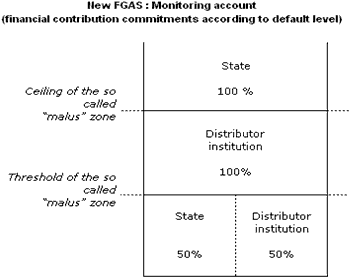

|
Guarantee system | version française |
|
Principles
The philosophy of successive systems focuses on two central concerns:
The operational principles based on this philosophy lead to three procedures depending on the default level :
Nature and definition of FGAS and new FGAS guarantee
The FGAS and new FGAS guarantee is a State guarantee whose principal
features are defined by agreement.
In the event of borrower default, its purpose is to compensate any
loss, defined as a reduction in the actuarial yield rate expected by
the credit institution when granting the loan, taking account, where
appropriate, of the portion of ancillary costs legally recoverable
from the borrower.
Two conditions must be fulfilled before a loss may be compensated by
FGAS: firstly, registration of the loan in FICP (French creditor
default file), and secondly, proof from the credit institution of the
occurrence of an event described in the agreement (contractual
recovery plan, executory court order, collective procedure, amicable
or forced sale, debts deemed irrecoverable). However, SGFGAS may
indemnify the loss even if FICP registration has not yet been made,
for borrowers whose long-term situation is compromised.
The very wide definition of default which may be compensated enables
FGAS/new FGAS to intervene not only in standard litigious cases
leading to a sale with the usual social consequences, but also before
the litigious stage for the bona fide borrower who has, for a
particular and temporary reason (job loss, divorce, illness, etc),
been unable to meet his repayments.
Such preventive action is designed to enable a borrower in difficulty
to achieve his property ownership project under conditions which
satisfy all parties.
The guarantee covers the charges in the debit account at the credit
institution, i.e. :
The FGAS/new FGAS guarantee does not cover cancellation compensation
nor other costs not mentioned (in particular, dispute management
costs).
Finally, it is a guarantee which, in principle, may only come into
play when all other guarantees have been used.
"Monitoring account" process
To oversee its mission, SGFGAS publishes, at least once a year,
monthly-updated "monitoring accounts" which set out the
commitments of the credit institutions and the State resulting from
the principles described in the preceding chapter. These
"monitoring accounts" enable in particular the supervision
of trespassing the various default thresholds and ceilings. A
monitoring account is prepared per affiliated credit institution
(within the meaning of banking law) and per loan generation (one
generation corresponds, unless excepted, to all loans disbursed during
the same year).
The Company also knows the details of each loan declared except the
name of the borrower, and monitors the events occurring during the
life of this loan (modifications to initial capital, total premature
repayment, payment incidents, default, etc). It also monitors the
obligatory annual declaration of outstanding amounts and quarterly
declarations of payment incidents.
SGFGAS sends monitoring indicators prepared by its data system to the
credit institution.
The monitoring account is shown as follows :

In the event of default, the credit institution may apply for
compensation to SGFGAS.
Old FGAS / New FGAS : what has changed / what hasn't changed
The main changes :
What hasn't changed :
Everything else, including :
Risk supervision authorities have accordingly always granted a
favorable treatment for FGAS guaranteed loans in comparison to non
guaranteed mortgage loans. They benefit from a lower capital
allocation ratio (risk weighting).
Thus, as of today loans with a mortgage lien have a 35% risk
weighting (loans with no mortgage lien, which is often the case in
France, have a higher weighting) "old FGAS" loans, as they
get a 100% state guarantee cover, benefit from a 0% risk
weighting.
For "new FGAS" loans, benefitting from a 50% State
guarantee, the risk weighting is now 17.5% (i.e. 50% of the mortgage
risk weighting).
The French risk supervision authority (ACPR, Autorité de
Contrôle Prudentiel et de Résolution) will monitor on a
yearly basis the results of the FGAS scheme and depending on the
observed loss ratios, may decide to modify the risk weighting.
More information on risk weighting can be found on the following link
to a notice issued by ACPR in 2014:
http://acpr.banque-france.fr/fileadmin/user_upload/acp/Communication/Communication_a_la_profession/201408-notice-modalites-calcul-ratios-prudentiels-cdriv.pdf
| Statistics | Back to top |